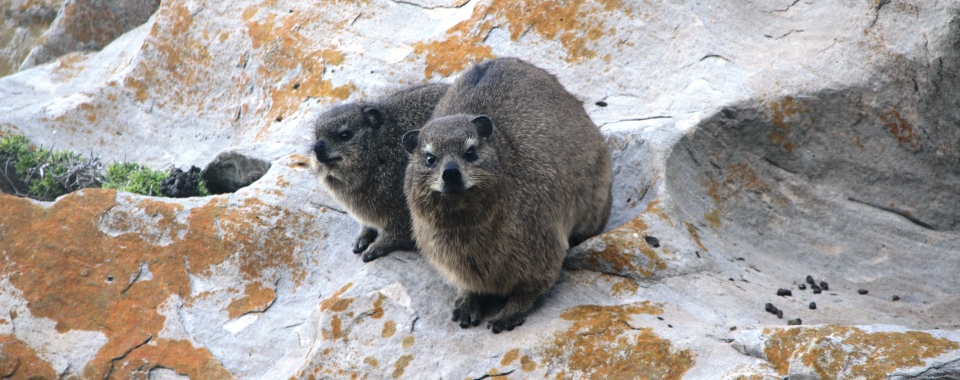Interesting facts on Dassies (Procavia carpensis)
Dassies are the Afrikaans and most commonly name used for a small mammal, Procavia carpensis (Latin) in South Africa. Their Latin names means the first guinea-pig (Procavia) belonging to the cape (carpensis). They are known in english as a Rock Hyrax and got that name from the Hebrew word shaphan that means “the hidden one”. They are also referred to as pelele (Swahili) and Rock rabbit. Dassies are social animals living in colonies of four to sixty individuals. They are grazers and can eat up to 75 different plant species including some poisonous ones. Their favourite plant parts are new shoots, fruits and berries, but they can eat bark if needed. They feed within 50-100m of their home, but when in groups feed further away from the rock.
Dassies look like large, heavily built rabbits with a maximum size of 5.6 kg and maximum length of 55cm. Their head is sharply pointed with short ears and they have a small tail, 4 toes on the front feet, and only 3 on the hind feet. Each back foot has a longer claw-like toe that they use for grooming and climbing. Their feet are well adapted for climbing by having sweat glands that increase their grip while running and jumping. A part of the underside of their feet can retract, creating a suction cup for extra grip. They are brownish grey with long (18cm) black whiskers. Dassies eyes are unique as parts of the iris are shaped to cut off light coming directly from above the animal. This helps them to see predators coming out of the sun.
Dassies become sexually mature at 16-17 months of age and the female are in heat once a year. There is one territorial male in the family group with supporting males and during the breeding season the male’s testes can increase up to 20 times in weight. Their gestation period is 201-243 days with a litter size of 1-6 young. All females in one family give birth within a 3 week period. The new-born weigh between 170-240 grams and are fully developed (unlike rodents). They start eating food after 3-4 days and after 14 days they will eat solid food together with milk. Their weaning occurs at 3-5 months of age. They can live for up to 10 years in the wild.
Dassies can be found through most of southeast Africa and the Middle East on rocky outcrops and cliffs. Their habitat ranges from sea level to over 4000m (on Mount Kenya). They favour cracks and crevices for their burrows where the inside temperature only varies by around 4 degrees Celsius keeping them warm at altitude at night. If their burrow is located in a windy area they generally use the entrance that is protected from the wind and can alter their burrow to get the entrance out of the wind.
Dassies are classified by the International Union for the Conservation of Nature (IUCN) as least concern since they have a wide distribution that occurs in a large number of protected areas. There are no major threats to the Dassies population and they serve as an important food source for the Verreaux’s eagle (Black eagle, Aquila verreauxii ) . Other predators include several large birds of prey, leopards, lions, jackals and snakes. Humans also snare them for their skin, meat and to use their urine in traditional medicine. It was used by South Africans and Europeans to mainly treat epilepsy, convulsions and hysteria
In Plettenberg Bay Dassies can be seen all along the Robberg peninsula. When visiting the seal colony by boat with Ocean Blue they can be seen running around amongst the rocks and seals.
References
– Strode Y. 2005 Rock Hyrax Studbook Procavia capensis Compiled by Yvonne Strode Peoria’s Glen Oak Zoo Data current as of 01 March 2005
– Oids N. Shoshani J. 1982 MAMMALIAN SPECIES Procavia capensis The American Society of Mammalogists No. 171, pp. 1-7.
– www.iucnredlist.org/details/41766/0





